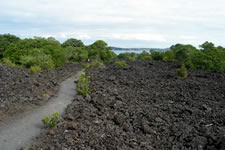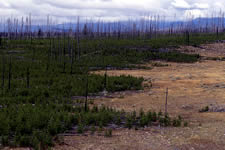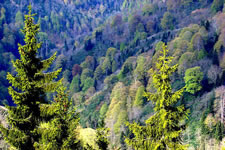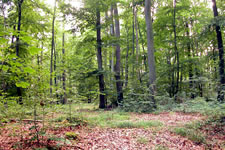Ecological Succession
Ecosystems are dynamic and endure nearly constant changes. Forest fires, urban development, volcanic eruptions, and strong storms are just some examples of events that can dramatically change the way an ecosystem looks and operates. But after such a disturbance, what happens to the ecosystem?
Let's chat with Ranger Cory about this in the tutorial below. Click the image below.
Text Version
 Lab: Ecological Succession
Lab: Ecological Succession
You've learned that ecological succession is a natural process that describes how different assemblages of organisms appear over time following a disturbance.
Have you seen any examples of this in your community?

How do ecologists measure successional stages? Is there any way to predict what future ecosystems will look like? In this lab activity you'll compare the successional stages of two sites in your local community.
Lab Objectives:
- Understand the concept of succession.
- Be able to describe the different stages of succession and give examples of plants in each period.
Before beginning this activity, make sure you have all of the materials you will need. If some of the specific items in the list below are unavailable to you, be creative!
If you don't have a 10m measuring tape (who does?) you could get some string and make marks every meter (or you could just pace off 10 meters and mark the corners of a 10m x 10 m study area).
You need to identify trees, but this might not be possible because the ID Key is for North American trees. What to do?
How about taking a picture of each tree in your plot (see lab worksheet) and comparing them. You may only have 2 or 3 different types of tree, and these images will be accepted.
Name them species #1, #2 or #3--as long as there is see some evidence (like photos) that show the similarities (such as bark type, branching pattern, leaf or needle type and shape, and cones/seeds/fruit).
Live in a city? You can use school grounds (most have trees somewhere), or a local park or vacant lot. Even in the biggest cities there are parks.
Suggested Lab Materials:
- Tree and Shrub ID guide
- Tree and Shrub Guide
- Species by State Search
- Virtual Dichotomous Key
- or other resource you find in the library or online like a plant identifer app on your mobile device.
- Measuring Tape
- Notebook and pencil
- Calculator
- Lab worksheet
 Lab: Examples of Ecological Succession
Lab: Examples of Ecological Succession
Use the images below to refresh your memory of what early and late successional stages look like.
 Primary Succession |
 Secondary Succession |
 Secondary Succession |
 Late Stage Succession |
 Late Stage Succession |
Reading Guide
As you read your text, keep an eye out for the answers to the following questions. Use the reading guide worksheet to take notes as you go along.
- What is ecology?
- What are the major components of an ecosystem?
- What happens to energy in an ecosystem?
- How do ecosystems respond to changes and disturbances?
Ecology Review
Please complete the following game to review the information from this section. Click the image to start the review.
Text Version
 Graded Assignments
Graded Assignments
Congratulations on completing this section! In this section you learned about:
- Define ecology.
- Explain the roles that organisms, communities, and populations play in the functioning of an ecosystem.
- Explain the flow of energy through an ecosystem using the laws of thermodynamics, food webs, food chains, and eco-pyramids.
- Explain the process of ecological succession in ecosystems.
Please return to your Schoology classroom L3 - Ecology folder to complete any graded assignments for this section.



